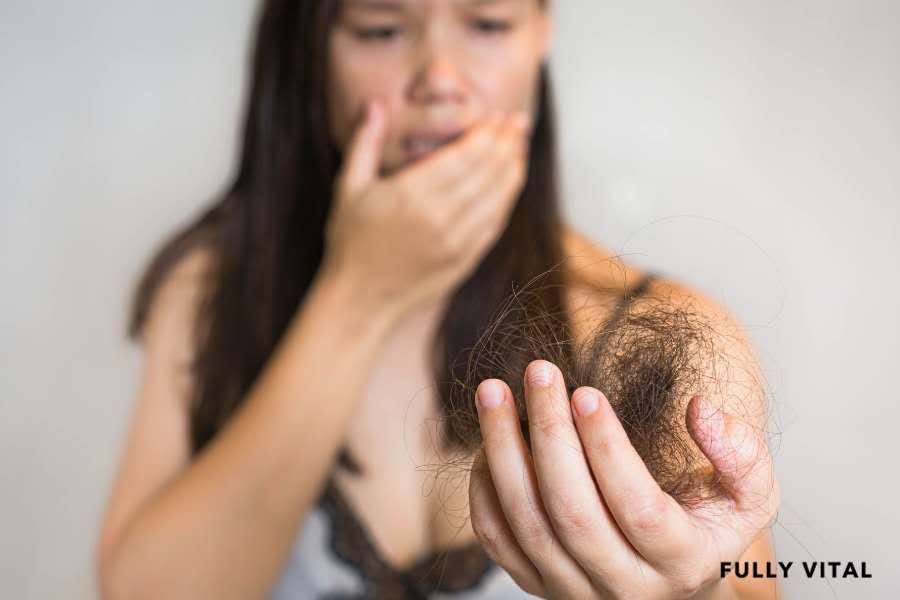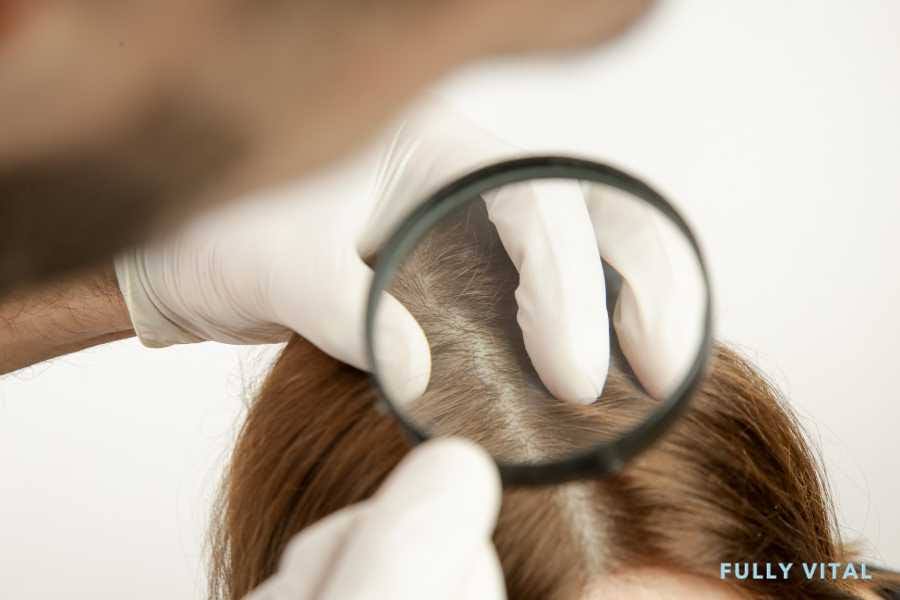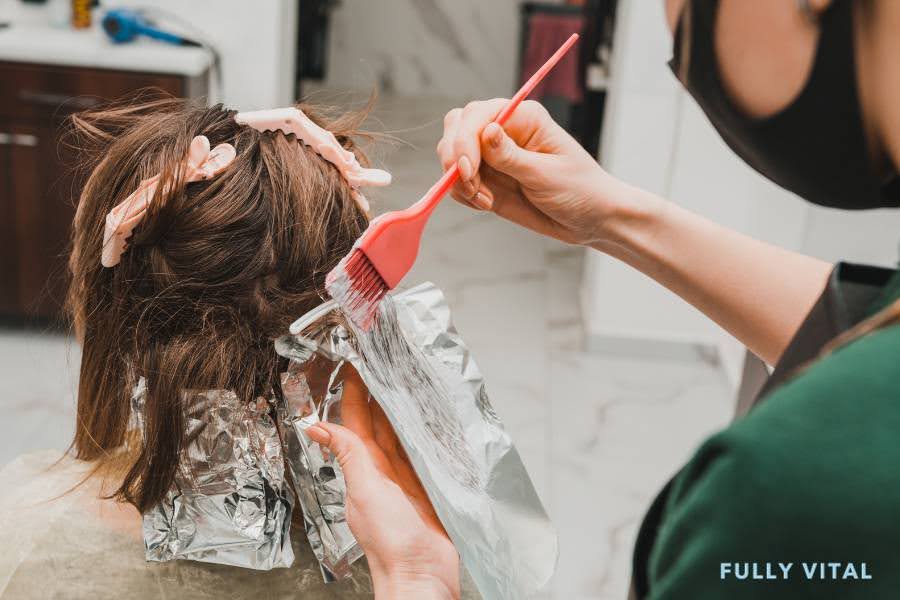
Unlock Vibrant Hair: Effective Solutions For Tackling Dead Strands
Hey there!
Are you tired of looking in the mirror and seeing dull, lifeless locks staring back at you?
Do you feel like no matter how much you trim, condition, or pamper your hair, those dead strands just won't say goodbye?
Well, you're not alone. A lot of us struggle with keeping our hair vibrant and alive.
You might think that dead hair is just a part of life, but I'm here to give you some hope!
At Fully Vital, we understand how frustrating it can be when your hair isn't looking and feeling as youthful and lively as you want.
That's why we've put our brains and passion into creating hair growth products to combat that very problem.
Our goal? To give you back the power to turn those frown-inducing, tired strands into a glossy mane full of life.
Whether it's because of the environment, stress, or just the ticking clock of hair life, we've got some nifty tricks up our sleeve to help breathe new life into your hair.
So, if you're ready to take action and wave 'sayonara' to dead hair, stick around. Let's get that shine back in your tresses together!

I LOVE MY HAIR NOW
FullyVital hair serum and hair vitamins made tremendous improvements in my hair. I truly love my hair now.
Dorit S.,
Understanding The Problem: What Makes Hair Strands "Dead"
Hair strands can appear lifeless or "dead" due to damage from heat styling, coloring, and sun exposure.
This damage affects the cuticle, the hair's protective outer layer, leading to weak, brittle, and dull hair.
While hair isn't "alive" like skin, "dead hair" refers to strands that are irreparably damaged.
Hair, composed of keratin, doesn't regenerate once harmed.
However, preventive care and proper treatment can maintain hair's health and appearance, avoiding the point of irreversible damage.
Importance Of A Nutrient-Rich Diet
When we think about hair care, we often focus on the products we use directly on our hair.
But one of the key factors in maintaining healthy and lively hair is the nutrition we feed our bodies.
Yeah, you heard it right – what you eat plays a huge role in the health of your hair!
Imagine your hair is like a plant.
Just like a plant needs the right soil nutrients to grow, your hair needs the right food to flourish.
A diet rich in vitamins, minerals, and healthy fats can help your hair stay strong, grow faster, and avoid damage that leads to those pesky dead strands.
Let's talk about some hair-loving nutrients that you should include in your diet:
- Protein: Hair is primarily made of protein, so getting enough of it is crucial. Look for lean proteins like fish, chicken, and legumes.
- Iron: A lack of iron can actually cause hair loss.1 Spinach, lentils, and red meat are great sources to keep your iron levels topped up.
- Omega-3 fatty acids: These keep your hair hydrated and shiny. Find them in fish like salmon, as well as in flaxseeds and walnuts.2
- Vitamin E: This one's known for its antioxidant properties that can protect your hair from harmful sun damage.3 Nuts and seeds are packed with vitamin E.
- B vitamins (especially Biotin): Biotin has gained a reputation for its hair growth superpowers. Eggs, avocados, and almonds are all excellent sources of biotin and other B vitamins.

How To Spot Damaging Hair Practices
Spotting the bad habits that are damaging your hair is the first step to preventing those lifeless strands.
We often do things out of routine, not realizing they're doing more harm than good.
Here's how you can spot those sneaky damaging hair practices:
Overdoing Heat Styling
Heat styling, like using flat irons, curling wands, or blow dryers, can fry your hair over time.
If you can’t skip using these tools, always use a heat protectant before styling.
Aggressive Brushing
When you tug at tangles with a brush or comb, especially when hair is wet, you risk breaking it.
Use a wide-toothed comb or a specially designed detangling brush and take your time to gently work through the knots.
Chemical Overload
Treatments like coloring, perming, or chemical straightening can cause significant damage when overused.
If your hair feels dry, brittle, or starts breaking easily after these treatments, it's a sign that you’re overdoing the chemicals.
Skimping on Trims
Avoiding regular trims can lead to split ends, which travel up the hair shaft and weaken it.
Although trims don't make your hair grow faster, they help keep ends fresh, preventing further breakage and the appearance of dead hair.
Using the Wrong Products
Using hair care products that are not suited for your hair type can lead to buildup and lackluster locks.
Make sure you’re using the right shampoos, conditioners, and styling products that cater to your specific hair needs.
Overwashing or Underwashing
Washing hair too frequently can strip it of its natural oils, leading to dry, brittle strands.
On the flip side, not washing enough can lead to a buildup of products and oils, which can damage hair and hamper growth.
Tight Hairstyles
Regularly wearing your hair in tight styles like ponytails, buns, or braids can put a strain on your hair follicles and potentially lead to hair loss known as traction alopecia.
Recognizing and modifying these habits can help prevent further damage to your hair.
Awareness is key—once you know which practices are harmful, you can take the necessary steps to adjust your routine and promote healthier, more vibrant hair.
Essential Oils: A Natural Rescue For Dead Strands
Sometimes, the best solutions come straight from nature.
That's where essential oils come in—they're like a superhero team for your hair.
Packed with natural properties, essential oils can help give your hair new life and support a healthy scalp, which is the foundation of good hair health.
Here, we're going to highlight some of the most effective essential oils that can help revitalize your hair:
Peppermint Oil
Known for its tingling sensation, peppermint oil can stimulate your scalp, encouraging blood flow.
The more blood flowing to your scalp, the more nutrients and oxygen to support hair growth—making your hair look energized and alive!
Lavender Oil
If you're after something that both soothes and nourishes, lavender oil is your go-to.
Besides smelling amazing, it's known for its ability to deeply condition the hair, keep the scalp clean, and help fight against dandruff.
Rosemary Oil
Meet rosemary oil—the tough love your hair sometimes needs.
It's fabulous for promoting hair thickness and growth.
It even helps in preventing hair loss, targeting those areas where your hair might be thinning.
Tea Tree Oil
Say goodbye to a dry, itchy scalp with tea tree oil.
With its powerful cleansing, antibacterial, and antimicrobial properties, it keeps your hair growing healthy by unblocking hair follicles and soothing the scalp.
Argan Oil
Sometimes called 'liquid gold,' argan oil is rich in antioxidants, essential fatty acids, and vitamin E. It hydrates and softens your hair, giving it that glossy, frizz-free shine that screams life!
Jojoba Oil
Jojoba oil is the hydration hero.
It moisturizes the hair, adds nutrients, and stimulates the scalp.
It’s super similar to the natural oils our bodies produce, making it a natural, gentle treatment for improving hair health.

Value Of Vitamins: Best Supplements For Hair Health
When it comes to revamping your hair care routine, considering the right supplements can be a game-changer.
Adding vitamins to your daily regime can give your hair that extra boost it needs to stay strong and vibrant.
Think of them as your personal hair care cheerleaders, rooting for your strands from the inside out.
Here's a breakdown of the best supplements that could help your hair health reach new heights:
Biotin
Also known as Vitamin B7, Biotin is one of the most raved-about vitamins for hair growth and overall hair health.
It helps in the production of keratin, which is the primary protein that makes up your hair.
Biotin deficiencies can lead to brittle hair or even hair loss, so ensuring you have enough can help keep your hair strong.
Vitamin C
Free radicals can damage your hair, making it weak and brittle.
Here's where Vitamin C comes to the rescue with its powerful antioxidant properties, fighting off oxidative stress that can affect hair growth.
Plus, Vitamin C is essential for producing collagen, a key part of hair structure.
Vitamin E
Just like Vitamin C, Vitamin E is an antioxidant that combats oxidative stress.
Taking a Vitamin E supplement can boost your hair health by providing protection against damage to the hair follicles.
Iron
Iron helps red blood cells carry oxygen to your cells.
This is vital for many bodily functions, including hair growth.
Iron deficiency, which is a common cause of hair loss, especially in women, can be remedied by taking an iron supplement to encourage regrowth and reduce shedding.
Zinc
Zinc plays a significant role in hair tissue growth and repair.
It also helps keep the oil glands around the follicles working properly.
Hair loss is a common symptom of zinc deficiency, so supplementation can help prevent this issue.
Omega-3 Fatty Acids
These healthy fats have anti-inflammatory properties that can help open up the hair follicles and promote hair growth.
Omega-3s also add elasticity to your hair, which means less chance of breakage.
Vitamin A
All cells need Vitamin A for growth, and this includes hair, the fastest growing tissue in the human body.
Vitamin A can also help skin glands produce sebum, which moisturizes the scalp and keeps hair healthy.
Vitamin D
Low levels of Vitamin D are linked to alopecia, the technical term for hair loss.
Research shows that Vitamin D could help create new follicles, the tiny pores where new hair can grow.
Vitamin D, "the sunshine vitamin," is another key player in maintaining robust hair.
Discover The Power Of Youthful Hair With Fully VitalAre you striving for a mane that radiates vitality, no matter your age? Fully Vital has harnessed the essence of youthful hair, infusing it into every bottle of our innovative hair growth products. We're not just about reinvigorating your hair—we're about nurturing a healthier relationship with your locks. Here's why making the switch to Fully Vital is the smart choice for your hair's future:
Make the commitment to your hair's longevity today. Choose Fully Vital, and take the first step towards a fuller, more vibrant head of hair that doesn't just grow—it thrives. |
Final Thoughts On Dead Hair
Saying goodbye to dead hair and hello to a head full of vibrant strands is totally within your reach.
By understanding the root causes of hair damage, tweaking your daily habits, and giving your hair the nutrients it needs to thrive, you can transform your locks from lifeless to lively.
With the help of essential oils, smart hair care practices, and the power of the right vitamins, you'll be on track to maintaining a gorgeous, healthy mane.
Remember, your hair's vitality starts with the love and attention you give it, both on the inside with a nutrient-rich diet and on the outside with proper care and the right products.
Fully Vital is here to support your journey every step of the way, offering products that cater to your unique hair needs and help you cultivate a more healthy relationship with your locks.
Take control of your hair's health and embrace the change.
Vibrant hair isn't just a dream—it's your reality waiting to shine through.
With a little commitment and the right tools, you're ready to unlock the full potential of your hair and let your true vitality show!
Check out our recent blogs:
- Effortless Elegance: How To Style And Preserve Your Back Bun With Ease
- Hairbrush Maintenance 101: How Often Should You Replace Your Hairbrush?
- The Ultimate Guide To Prenatal Vitamins And Hair Growth: Are They Worth The Hype?
Frequently Asked Questions About Dead Hair
What causes dead hair strands?
Dead hair strands are often the result of damage from over-styling, heat, coloring, and chemical treatments.
Poor nutrition, stress, and environmental factors like sun exposure can also contribute to hair looking lifeless and damaged.
What do dead hair follicles look like?
It's tricky to spot dead hair follicles just by looking, as they are under the skin.
However, if a follicle is dead, it will no longer grow hair, leading to bald patches or lack of hair growth in an area.
Can you tell if hair follicles are dead?
It's tough to determine if hair follicles are dead without professional analysis.
A dermatologist can examine your scalp and might use a microscope to get a closer look at your hair follicles' health.
How long does it take for dead hair to heal?
If hair is simply damaged and not "dead" (since hair strands are not technically alive), it may recover with proper care and treatment over several weeks or months.
However, dead hair won't heal, and new hair must grow in its place.
How do you know where your dead hair starts?
Split ends are usually where damage starts.
Look for brittle, thinning ends that are more prone to breakage.
You might also notice a texture change where the healthy hair meets the damaged hair.
What does over-processed hair look like?
Over-processed hair often looks dull and feels dry or straw-like.
It may be prone to breakage, have split ends, tangle easily, and lack elasticity, causing it not to bounce back when stretched.
What does dead hair feel like when wet?
Dead or severely damaged hair might feel gummy or extremely fragile when wet.
This is due to the breakdown of the hair's structure and cuticle damage.
How do you know if your hair is dehydrated?
Dehydrated hair often looks lackluster, feels dry or rough, has split ends, and is difficult to manage or style.
It might also be more prone to frizz and static.
Can you fix dead hair without cutting it?
While you can't "fix" dead hair, you can improve the appearance of damaged hair.
Deep conditioning treatments, protein masks, and reducing heat styling can help restore some moisture and strength.
Nonetheless, trimming is necessary to remove totally split ends.
Can you reactivate dead hair follicles?
It's generally not possible to reactivate dead follicles, but dormant follicles might be stimulated to grow hair again.
Our hair growth products at Fully Vital are designed to nourish your scalp and create an environment where hair can thrive.
Sources:
- Rushton, D. H. (2002). Nutritional factors and hair loss. Clinical and Experimental Dermatology, 27(5), 396–404. https://doi.org/10.1046/j.1365-2230.2002.01076.x
- Rudin, D. O. (1996). Omega 3 Oils. In Google Books. Penguin. https://books.google.com.ph/books?hl=en&lr=&id=OmCM0tcNIHIC&oi=fnd&pg=PP7&dq=Omega-3+fatty+acids:+These+keep+your+hair+hydrated+and+shiny.+Find+them+in+fish+like+salmon
- Thiele, J. J., Hsieh, S. N., & Ekanayake-Mudiyanselage, S. (2006). Vitamin E: Critical Review of Its Current Use in Cosmetic and Clinical Dermatology. Dermatologic Surgery, 31, 805–813. https://doi.org/10.1111/j.1524-4725.2005.31724







